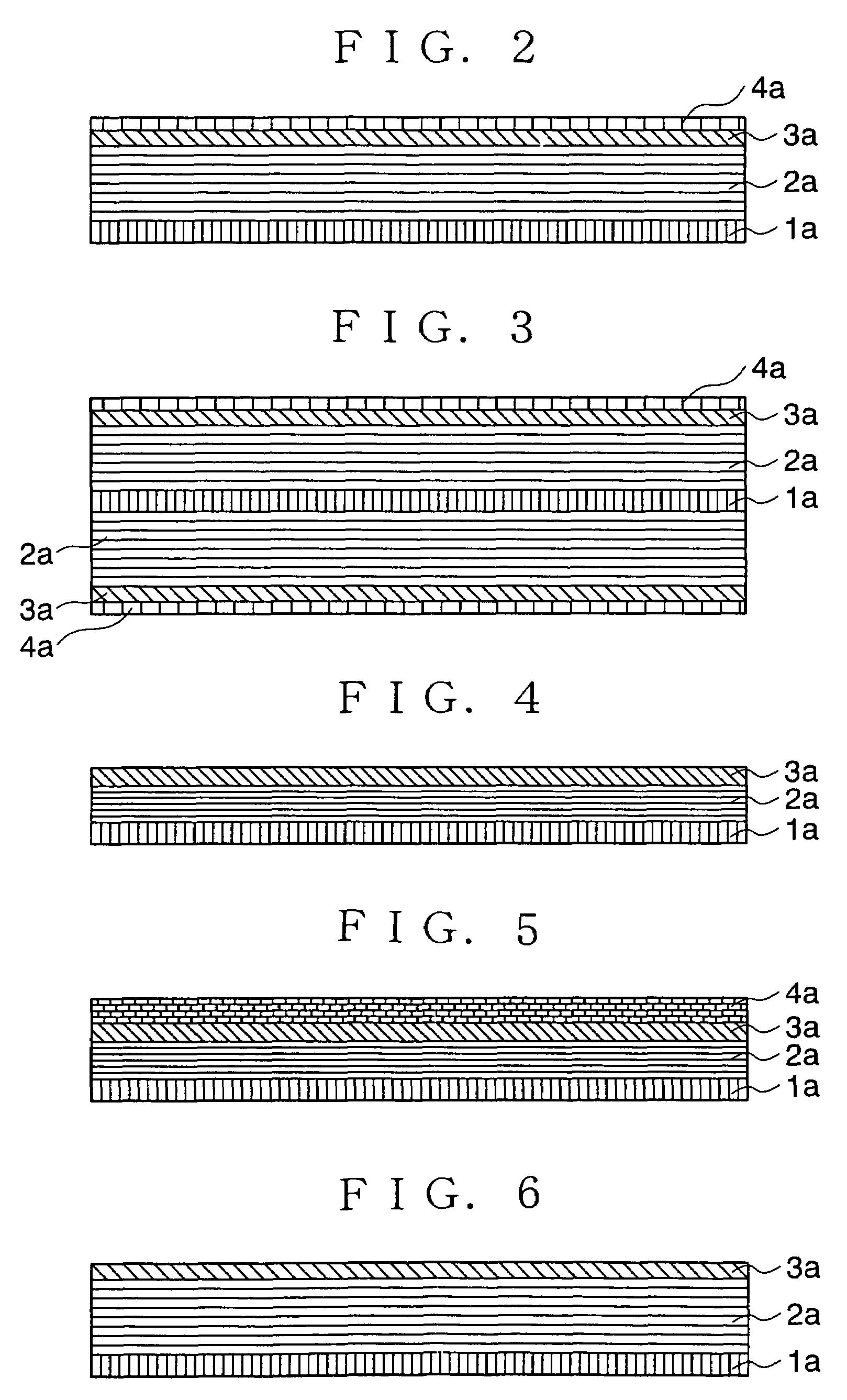Anode for secondary battery, secondary battery using same and method for fabricating anode
a secondary battery and anode technology, applied in the field of secondary batteries and secondary batteries, can solve the problems of reducing the battery life, shortening the charge-discharge cycle life, and shortening the cycle life of the battery, and achieve excellent cycle performance and high energy density
- Summary
- Abstract
- Description
- Claims
- Application Information
AI Technical Summary
Benefits of technology
Problems solved by technology
Method used
Image
Examples
example 1
[0108]In the present Example, a copper foil and graphite were used as a current collector 1a and the main component of a carbon anode layer 2a, respectively. A second anode layer 3a made of B2O3 was formed by using a vacuum-evaporation method. A third anode layer 4a made of metal lithium was formed by using a vacuum-evaporation method.
[0109]The anode of the non-aqueous electrolyte secondary battery shown in FIG. 2 was fabricated in accordance with the following procedures. The copper foil having thickness of 10 μm was used as the current collector on which the carbon electrode 2a was deposited. The first anode 2a was prepared by applying, on the current collector 1a, paste obtained by mixing graphite powder with poly-fluorinated vinylidene acting as a bonding agent and dissolved in N-methyl-2-pyrrolidone, and an agent for providing conductivity, followed by drying. After the drying, the first anode 2a was compressed by using a pressing machine. After the second anode 3a made of B2O3...
examples 2 and 3
[0124]In these Examples, a copper foil with thickness of 10 μm and hard carbon were used as a current collector 1a and a main components of a first anode layer 2a, respectively. Silicon was used as a second anode layer 3a which was formed by using a CVD method (Example 2) or a sputtering method (Example 3). A third anode layer 4a was made of metal lithium which was formed by using a vacuum-evaporation method. The reversible capacities of the anodes of Examples 2 and 3 were measured by using a coin cell having metal lithium as a counter electrode. A mixed solvent of propylene carbonate (PC) and ethyl methyl carbonate (EMC) dissolving 1 mol / liter of LiPF6 (mixed volume ratio: PC / EMC=40 / 60) was used as electrolyte. Measurement current was 0.1 mA, and a voltage range was 3 to 4.3 V (Li / Li+).
[0125]Non-woven propylene cloth was used as a separator, and a square battery was fabricated by combining the above cathode and anode. The ratios of the reversible capacities of the anodes in the bat...
examples 4 , 5 and 6
EXAMPLES 4, 5 AND 6
[0137]In these Examples, a copper foil having thickness of 10 μm and hard carbon were used as a current collector 1a and the main component of a first anode layer 2a, respectively. As a second anode layer 3a, SiOx (“x” is 0y (“y” is 0x layer and the SnOy layer were formed by using a evaporation method.
[0138]The SiSn layer was formed by using an evaporation method in which Si and Sn were placed in separate crucibles and deposited by using lasers. The ratio between Si and Sn was controlled by measuring the respective amounts of the evaporation with a quartz oscillator.
[0139]Lithium-indium alloy was used as a third anode layer 4a. The amounts of the lithium and the indium in the alloy were 98 weight % and 2 weight %, respectively. The lithium-indium alloy film was formed by using an evaporation method in which the lithium and the indium were placed in separate crucibles and deposited by using lasers. The ratio between the lithium and the indium was controlled by meas...
PUM
| Property | Measurement | Unit |
|---|---|---|
| pressure | aaaaa | aaaaa |
| distance | aaaaa | aaaaa |
| distance | aaaaa | aaaaa |
Abstract
Description
Claims
Application Information
 Login to View More
Login to View More - R&D
- Intellectual Property
- Life Sciences
- Materials
- Tech Scout
- Unparalleled Data Quality
- Higher Quality Content
- 60% Fewer Hallucinations
Browse by: Latest US Patents, China's latest patents, Technical Efficacy Thesaurus, Application Domain, Technology Topic, Popular Technical Reports.
© 2025 PatSnap. All rights reserved.Legal|Privacy policy|Modern Slavery Act Transparency Statement|Sitemap|About US| Contact US: help@patsnap.com



